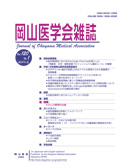

Journal of Okayama Medical Association
Published by Okayama Medical Association<Availability>
Full-text articles are available 3 years after publication.
Permalink : http://escholarship.lib.okayama-u.ac.jp/17339
Studies on endoscopic retrograde cholangiograms Part II Studies on cholangiograms in cases with stones in the biliary tract
Kikuchi, Takeshi
Published Date
1975-04-30
Abstract
Following conclusions were obtained on the basis of studies on endoscopic retrograde cholangiograms of 104 cases with stones in the biliary tract. 1) The biliary tract was successfully visualized in 104 cases (89.6%). The rate of success was high in cases of choledocholithiasis with a dilated bile duct. 2) Most frequently seen were cases of choledocholithiasis, cholelithiasis, or combination of both. 3) In the intrahepatic bile duct, stones were usually found in one of the first branches. In extrahepatic bile ducts, gallstones were usually impacted at the confluence of the common hepatic, cystic and common bile duct, or at the intraduodenal bile duct. Diagnosis of stones in the biliary tract were easily made due to the typical appearance of shadow-defect. 4) In cases with impacted gallstones in the neck of the gallbladder, cystic duct was disrupted. 5) Stones were found in 10 of 16 cases with a past history of cholecystectomy. 6) Dilatation and various abnormalities of the intrahepatic and extrahepatic bile ducts and the gallbladder were frequently observed in cases with choledocholithiasis. 7) Deformity, atrophy and stiffening of the gallbladder were frequently observed in cases with cholelithiasis. 8) Morphological and functional abnormalities of the Vaterian bile duct were frequently observed in cases of stones in the biliary tract. 9) As for endoscopic findings, the longitudinal and covering folds of the duodenal papilla wer swollen frequently in cases with choledocholithiasis, dilated bile duct and abnormal Vaterian bile duct. 10) Stones were found in 10 out of 16 cases with a spontaneous choledochoduodenal fistula.
ISSN
0030-1558
NCID
AN00032489
